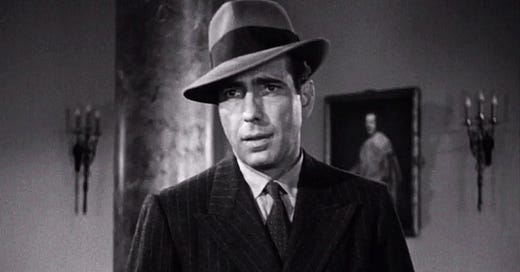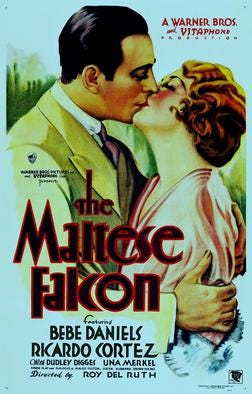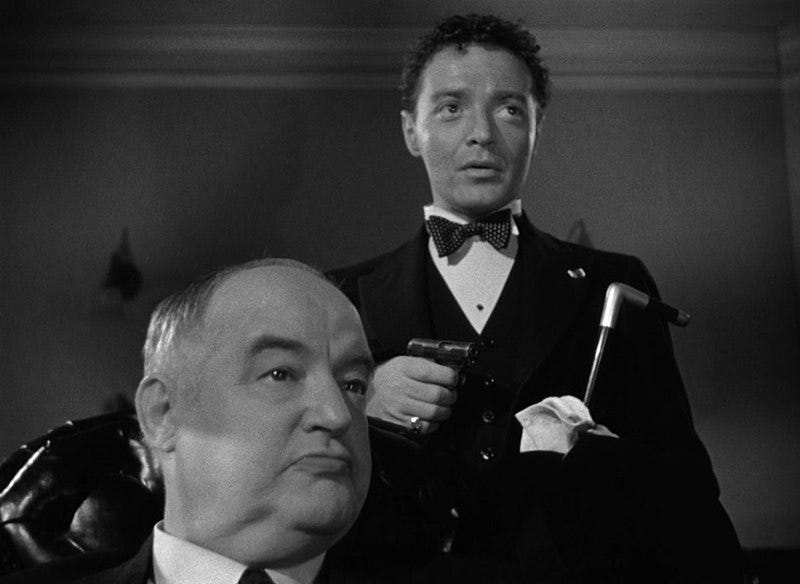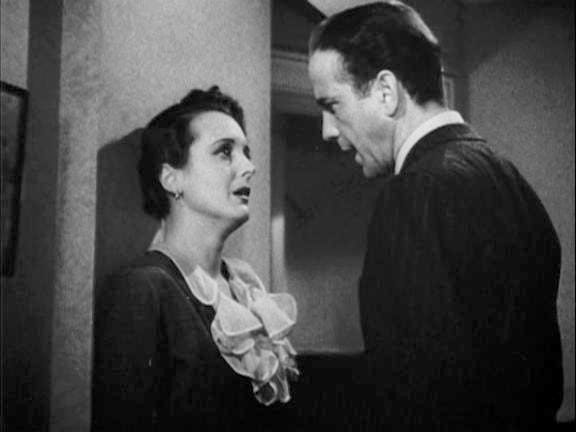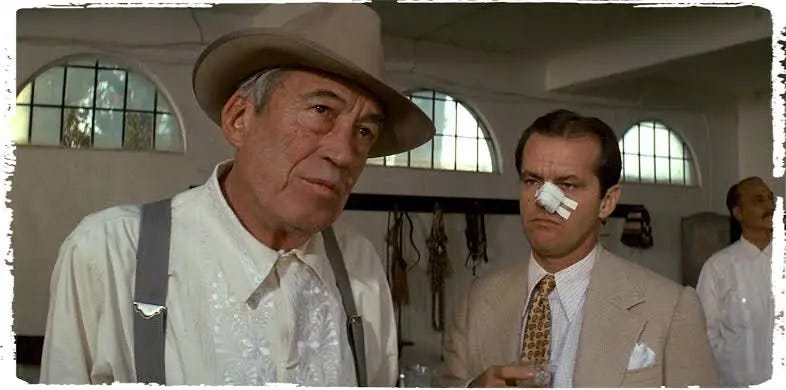The Maltese Falcon (1941)
Another San Francisco story that's full of noir staples and classic zingers!
The Maltese Falcon opens with a shot on the rare falcon itself with the following information:
In 1539 the Knight Templars of Malta, paid tribute to Charles V of Spain, by sending him a Golden Falcon encrusted from beak to claw with rarest jewels—but pirates seized the galley carrying this priceless token and the fate of the Maltese Falcon remains a mystery to this day.
- The introductory text appearing in the opening credits
This is a film that I’ve heard about so much over the years, but for some reason never got around to watching. I even bought it on Blu-Ray at a cheapo records for 5 bucks and still hadn’t popped it in the player to watch. Finally, I got around to it, and it’s another great 1941 release directed by a new-comer (the other being Orson Welles’s Citizen Kane of course!)
Fun fact: neither Citizen Kane or The Maltese Falcon won best picture that year. John Ford’s How Green is My Valley picked up the statue.
John Huston wrote and directed The Maltese Falcon at 35 years old, and even though that’s 10 years older than Welles was when he directed Citizen Kane, that’s still pretty young to direct a movie. 1941 definitely feels like a shift leading to younger voices coming to Hollywood, and both of these films are great examples of studios taking that chance on new directors.
The Maltese Falcon was a safer bet than Citizen Kane though. Huston was already a part of the Hollywood system, as his father, Walter Huston, was already an established name as an actor in the industry. In fact, Huston got his start as a writer by penning dialogue for his father’s films. Huston was given an inside look at how films were made on the set of A House Divided (1931), directed by William Wyler and starring his father. I think that’s why The Maltese Falcon feels much more traditional than Citizen Kane.
The film is based on the Dashiell Hammett novel of the same name and is a remake of the 1931 film that previously adapted the book. The story of the original film is fascinating in itself, and it’s definitely one I want to cover in the future. But we’re here to talk about the one everyone knows! The one starring the great Humphrey Bogart and Mary Astor!
Bogart plays private detective Sam Spade who runs a detective agency with his colleague Miles Archer. They meet with a woman who claims to be Ruth Wonderly (spoiler alert; she’s not!) about her missing sister who ran away from her home in New York and came to San Francisco with a man named Floyd Thursby. Later that night, Spade’s partner Archer is gunned down on the street. (Sam Spade, being the savage that he is, has Archer’s name removed from the agency the next day!)
Spade ends up discovering that Wonderly isn’t who she says she is, and is actually Floyd Thursby’s partner. Then, Spade gets mixed up in a complex web of lies and corruption that put his own morals into question. I’ll be honest, the story gets a little bit jumbled sometimes, and I do think that’s because it is so faithful to the Hammett book. While the story can sometimes lead the audience astray, the characters and the dialogue really pop in this film. There are many lines that I love, but this one takes the cake:
"When you’re slapped you’ll take it and like it!” - Sam Spade
The supporting performances in The Maltese Falcon are really what makes this movie such a blast. Peter Lorre, a renowned Hungarian actor who is known for playing quiet and terrifying villains (Fritz Lang’s M is maybe his most terrifying role, which I’ll be covering at some point!) But in this film, Lorre plays Joel Cairo, a man hired to follow Spade to see what he knows about the whereabouts of the statue. I found his performance to be very grounded, and at times, extremely funny. There’s a level of commitment that he gave in the performance that always drew my eyes to him, even if he wasn’t speaking.
Then there’s Sydney Greenstreet as the mastermind, Kasper Gutman. Greenstreet was a veteran stage actor from England, but surprisingly he had never been in a film up until this point. He had been offered many films up until this point, but he didn’t accept any offers until The Maltese Falcon when he was 61 years old. He and Peter Lorre would go onto star in twelve films together, one of them being Casablanca (1942), which obviously stars Humphrey Bogart as well.
And then there’s Mary Astor as Ruth Wonderly/Brigid O'Shaughnessy, the duplicitous and cunning partner in crime with her associate, Floyd Thursby. Mary Astor doesn’t play her hand too early, giving the romance between her and Bogart extra weight when he discovers that she’s been playing him the whole time. The thing that I think is brilliant about the writing of this film, is how real the romance is. I do truly think she was in love with Spade, but the circumstances just didn’t add up.
The Maltese Falcon was incredibly influential in the noir genre, and while I don’t think it’s quite as good as classic noirs like Double Indemnity (1944) or another Bogart classic, In a Lonely Place (1950), I do think it’s an important piece of cinema in terms of the genre and for John Huston’s career as an actor and director. Huston would later go on to star as one of the most iconic villains in Chinatown (1974), which was largely inspired by his own directorial debut.
Next week I’ll be covering a classic documentary from the early 1970’s that musical nerds will very much appreciate, along with a related documentary that was made in 2016! Stay tuned, and as always, make sure to subscribe and share with that film nerd in your life!

